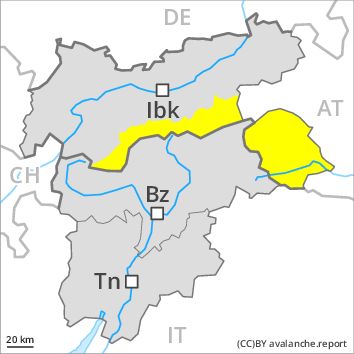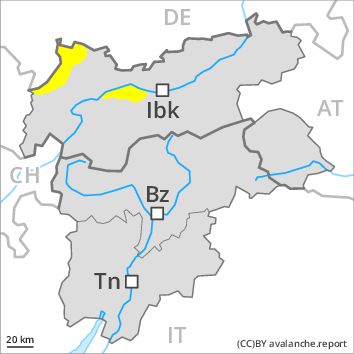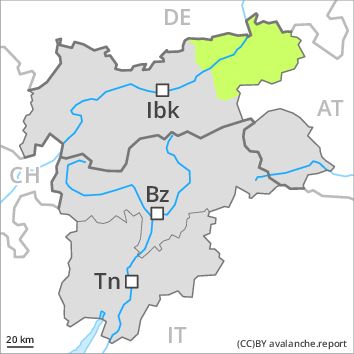Regions
Glockner Range, Eastern Deferegger Alps, Schober Mountains, Lienzer Dolomites, Gurgler Range, Central Stubai Alps, Northern Zillertal Alps, Venediger Range, Eastern Rieserferner Mountains

Danger level
Danger Level 2 - Moderate
Avalanche Problem
Gliding snow above 2600m, E-SE-S-SW-W
Persistent weak layer above 2500m, E-SE-S-SW-W

Areas with glide cracks are to be avoided. Weakly bonded old snow requires caution, in particular on sunny slopes above approximately 2500 m.
As the moisture increases small to medium-sized gliding avalanches and moist snow slides are possible. This applies in particular on steep sunny slopes below approximately 2600 m as well as at low and intermediate altitudes, especially in the regions with a lot of snow. Caution is to be exercised in areas with glide cracks.
Dry avalanches can additionally be released in near-surface layers, in particular by large additional loads. This applies in particular on very steep sunny slopes above approximately 2500 m at transitions from a shallow to a deep snowpack. These avalanche prone locations are rather rare and are barely recognisable, even to the trained eye.
Fresh wind slabs are mostly small and can only be released in isolated cases. Caution is to be exercised in particular adjacent to ridgelines at high altitudes and in high Alpine regions as well as on very steep shady slopes. Somewhat older wind slabs have bonded well with the old snowpack on shady slopes. Individual avalanche prone locations for dry avalanches are to be found in particular adjacent to ridgelines above approximately 2400 m. The avalanches are rather small. The avalanche prone locations are clearly recognisable to the trained eye.
Snowpack
dp 2: gliding snow
dp 7: snow-poor zones in snow-rich surrounding
Faceted weak layers exist in the top section of the snowpack on steep sunny slopes, in particular above approximately 2500 m. Over a wide area 10 to 20 cm of snow. will fall above approximately 1800 m. The fresh and older wind slabs are bonding well with the old snowpack. The snowpack will be subject to considerable local variations at high altitudes and in high Alpine regions. At low and intermediate altitudes the snow is moist, also on sunny slopes below approximately 2600 m.
Tendency
Gradual increase in danger of dry avalanches as a consequence of fresh snow and wind.
Regions
Grieskogel Mountains, Allgäu Alps

Danger level
Danger Level 2 - Moderate
Avalanche Problem
Gliding snow above 2600m, E-SE-S-SW-W
Wind-drifted snow above 2400m, N-NE-NW

Areas with glide cracks are to be avoided. Wind slabs at high altitude.
As the moisture increases small to medium-sized gliding avalanches and moist snow slides are possible. This applies in particular on steep sunny slopes below approximately 2600 m as well as at low and intermediate altitudes, especially in the regions with a lot of snow. Caution is to be exercised in areas with glide cracks.
Somewhat older wind slabs have bonded well with the old snowpack on shady slopes. Individual avalanche prone locations for dry avalanches are to be found in particular adjacent to ridgelines above approximately 2400 m. The avalanches are rather small. The avalanche prone locations are clearly recognisable to the trained eye.
Snowpack
dp 2: gliding snow
dp 6: cold, loose snow and wind
The somewhat older wind slabs have bonded well with the old snowpack. The snowpack will be subject to considerable local variations at high altitudes and in high Alpine regions. At low and intermediate altitudes the snow is moist, also on sunny slopes below approximately 2600 m.
Tendency
Gradual decrease in danger of gliding avalanches and moist snow slides as the temperature drops. Slight increase in danger of dry avalanches as a consequence of fresh snow and wind.
Regions
Western Tuxer Alps, Eastern Tuxer Alps, Western Lechtal Alps, Central Lechtal Alps, Glockturm Range, Weißkugel Range, Western Verwall Mountains, Eastern Verwall Mountains, Silvretta, Samnaun Mountains, Northern Oetz and Stubai Alps

Danger level
Danger Level 2 - Moderate
Avalanche Problem
Gliding snow above 2600m, E-SE-S-SW-W
Persistent weak layer above 2500m, E-SE-S-SW-W

Areas with glide cracks are to be avoided. Weakly bonded old snow requires caution, in particular on sunny slopes above approximately 2500 m.
As the moisture increases small to medium-sized gliding avalanches and moist snow slides are possible. This applies in particular on steep sunny slopes below approximately 2600 m as well as at low and intermediate altitudes, especially in the regions with a lot of snow. Caution is to be exercised in areas with glide cracks.
Dry avalanches can additionally be released in near-surface layers, in particular by large additional loads. This applies in particular on very steep sunny slopes above approximately 2500 m at transitions from a shallow to a deep snowpack. These avalanche prone locations are rather rare and are barely recognisable, even to the trained eye.
Somewhat older wind slabs have bonded well with the old snowpack on shady slopes. Individual avalanche prone locations for dry avalanches are to be found in particular adjacent to ridgelines above approximately 2400 m. The avalanches are rather small. The avalanche prone locations are clearly recognisable to the trained eye.
Snowpack
dp 2: gliding snow
dp 7: snow-poor zones in snow-rich surrounding
Faceted weak layers exist in the top section of the snowpack on steep sunny slopes, in particular above approximately 2500 m. The somewhat older wind slabs have bonded well with the old snowpack on shady slopes. The snowpack will be subject to considerable local variations at high altitudes and in high Alpine regions. At low and intermediate altitudes the snow is moist, also on sunny slopes below approximately 2600 m.
Tendency
Gradual decrease in danger of gliding avalanches and moist snow slides as the temperature drops. Slight increase in danger of dry avalanches as a consequence of fresh snow and wind.
Regions
Karwendel Mountains, Eastern Lechtal Alps - Ammergau Alps, Mieming Mountains

Danger level
Danger Level 2 - Moderate above the treeline
Danger Level 1 - Low above the treeline
Avalanche Problem
Gliding snow above 2600m above the treeline, E-SE-S-SW-W
Wind-drifted snow above 2400m, N-NE-NW

Areas with glide cracks are to be avoided. Wind slabs at high altitude.
As the moisture increases small to medium-sized gliding avalanches and moist snow slides are possible. This applies in particular on steep sunny slopes below approximately 2600 m as well as at intermediate altitudes, especially in the regions with a lot of snow. Caution is to be exercised in areas with glide cracks.
Somewhat older wind slabs have bonded well with the old snowpack on shady slopes. Individual avalanche prone locations for dry avalanches are to be found in particular adjacent to ridgelines above approximately 2400 m. The avalanches are rather small. The avalanche prone locations are clearly recognisable to the trained eye.
Snowpack
dp 2: gliding snow
dp 6: cold, loose snow and wind
The somewhat older wind slabs have bonded well with the old snowpack. The snowpack will be subject to considerable local variations at high altitudes and in high Alpine regions. At low and intermediate altitudes the snow is moist, also on sunny slopes below approximately 2600 m.
Tendency
Gradual decrease in danger of gliding avalanches and moist snow slides as the temperature drops. Slight increase in danger of dry avalanches as a consequence of fresh snow and wind.
Regions
Brandenberg Alps, Western Kitzbühel Alps, Wilder Kaiser Mountains - Waidring Alps, Eastern Kitzbühel Alps

Danger level
Danger Level 1 - Low
Avalanche Problem
Wind-drifted snow above 2400m, N-NE-NW

Wind slabs require caution.
The older wind slabs represent the main danger. The avalanche prone locations are to be found in particular on very steep shady slopes above approximately 2400 m. Caution is to be exercised in particular adjacent to ridgelines. Such avalanche prone locations are very rare and are clearly recognisable to the trained eye.
Snowpack
dp 6: cold, loose snow and wind
The wind slabs have bonded well with the old snowpack. The snowpack will be moist at low and intermediate altitudes. This also applies on steep sunny slopes at high altitude. Thus far only a little snow is lying.
Tendency





